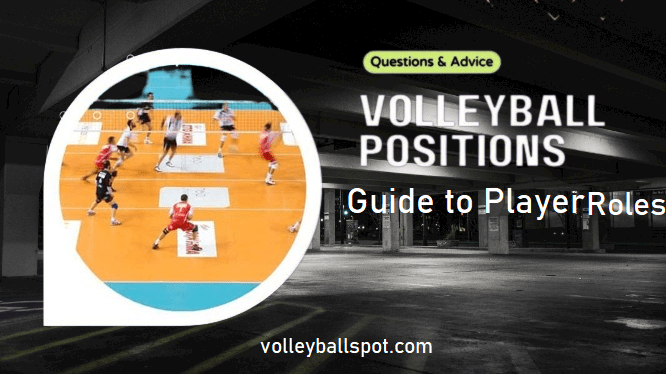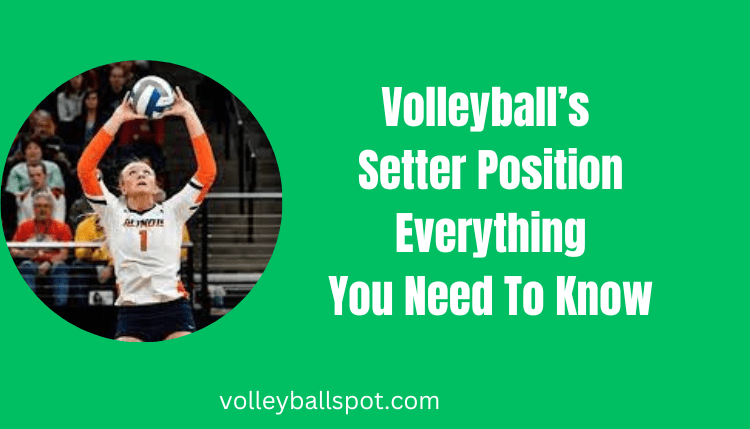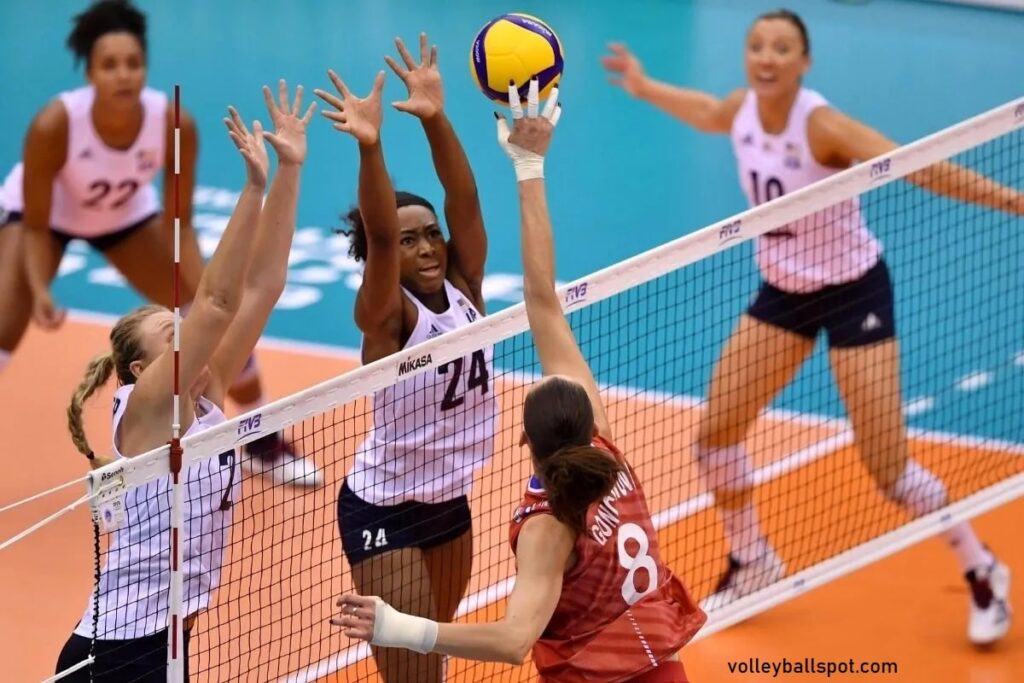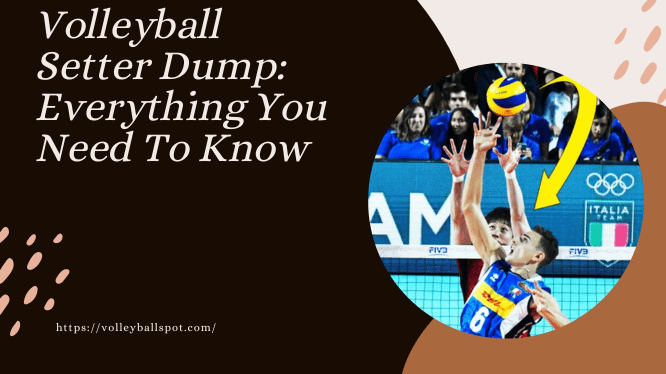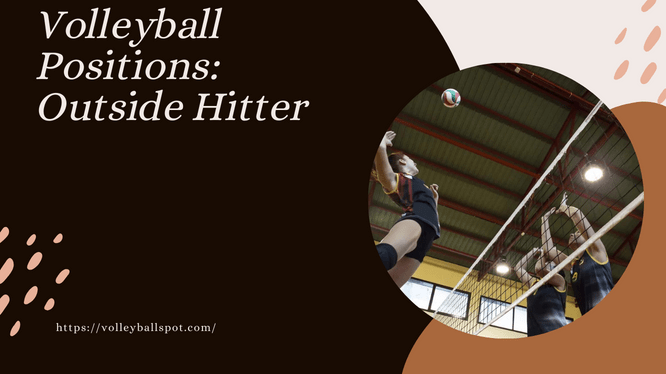
In volleyball positions an outside hitter holds a vital role on the court. Also known as a left side hitter, this player is responsible for both hitting and blocking on the front left side of the court. As one of the main passers and go-to hitters on offense, the outside hitter plays a crucial role in scoring points for their team. They often receive numerous opportunities to swing at the ball due to their exceptional hitting skills. Additionally, when a pass is not perfect, the ball tends to go towards the outside area of the court, making it an ideal target for the outside hitter. In such situations, executing a high outside set becomes the easiest and safest choice when other options are unavailable. The versatility and importance of an outside hitter make them an integral part of any successful volleyball team .
What Does an Outside Hitter Do During a Play?
During a play, an outside hitter in volleyball takes on various important roles to contribute to their team’s success. Let’s explore what an outside hitter does during a play:
- Passes the ball in serve receive: As one of the main passers, the outside hitter plays a crucial role in receiving and controlling the opponent’s serve. Their ability to make accurate passes sets up their team for a successful offensive play.
- Calls out the hitters on defense: On defense, the outside hitter takes charge by calling out the hitters on the other side of the net. This helps their teammates anticipate and react effectively to block or defend against incoming attacks.
- Watches the hitters: The outside hitter closely observes and analyzes the opposing team’s hitters to determine which one is coming her way. This allows them to position themselves strategically and be prepared for any attacking opportunities or defensive actions.
- Sets the block: An outside hitter collaborates with their middle blocker to set up an effective block against opposing attackers. They ensure that they position themselves correctly so that the middle blocker can close in on them, creating a strong defensive wall.
- Runs offensive plays: On offense, an outside hitter executes plays as directed by the setter. They follow specific patterns and movements designed to create scoring opportunities for their team.
- Ready for swings or good plays: Regardless of whether they receive a good or bad set from their setter, an outside hitter remains ready to take a powerful swing at the ball or make a skillful play over the net. Their versatility allows them to adapt and contribute positively during each play.
- Covers other hitters: The outside hitter is diligent in covering other hitters on their team during both offensive and defensive situations. They stay low and ready to play or run down balls while ensuring that no gaps are left uncovered.
The role of an outside hitter is multi-faceted and requires a combination of skills, including passing, attacking, blocking, and defensive awareness. Their contributions play a crucial part in the overall success of their team on the volleyball court.
What Attributes Are Important in an Outside Hitter?
When it comes to an outside hitter in volleyball, several attributes are crucial for excelling in this position. Here are the important attributes:
- Good height: While being tall can be advantageous for an outside hitter, it is not necessarily a requirement to be the tallest player on the team. A good height allows them to reach higher and have an advantage when attacking or blocking at the net.
- Good ball-handling skills: An outside hitter should possess excellent ball-handling skills. This includes having precise control over their passes, sets, and hits. Strong hand-eye coordination and the ability to handle different types of balls are essential.
- Good passer and digger: Outside hitters need to be proficient passers and diggers in order to effectively receive serves and defend against opponents’ attacks. They must have the ability to accurately pass the ball to their setter while under pressure from strong serves.
- Solid hitter: A key attribute of an outside hitter is being a solid hitter who can deliver powerful kills when presented with a perfect set from their setter. Additionally, they should also be capable of adapting their hitting technique when receiving off-the-net or over-the-shoulder sets.
These attributes allow an outside hitter to contribute significantly during both offensive and defensive plays, making them a valuable asset to any volleyball team.
While these attributes are important for an outside hitter, it’s worth noting that each player brings their own unique strengths and style of play to the position. Developing these attributes through practice, training, and experience will help an outside hitter excel on the court.
Starting Position
Starting Position
The outside hitter plays on the front left side of the court. As she rotates through the front row, she will move from middle front or right front to her spot on the left side once the serve crosses the net.
The starting position for an outside hitter in volleyball is on the front left side of the court. As the game progresses and the outside hitter rotates through the front row, she will move from either the middle front or right front to her designated spot on the left side once the serve crosses the net.
This positioning allows the outside hitter to be strategically placed for both offensive and defensive plays. In terms of offensive strategy, being positioned on the front left side enables them to be a lead attacker and primary option for receiving sets from their setter. They can then execute powerful hits or kills to score points for their team.
On defense, the outside hitter’s starting position allows them to effectively block and defend against attacks coming from opponents on their side of the net. Their positioning also enables them to cover other hitters and contribute to overall team defense.
It’s important for an outside hitter to have good court awareness, communication skills with teammates, and adaptability in adjusting their starting position based on specific game plans and rotations.
Play Development
During play development, the outside hitter plays a crucial role in coordinating and executing offensive and defensive strategies. Before the ball is served, the outside hitter must have a clear understanding of where all the hitters on both teams are positioned on the court. This allows them to anticipate and react accordingly as the play unfolds .
As the play develops, the outside hitter closely watches the movement of all players on the court, including her own teammates and opponents. By observing these movements, she can call out specific plays to help guide her middle blocker in following hitting patterns and positioning themselves for effective blocks .
The outside hitter’s primary responsibility is to watch for the player who will hit on her side of the court. Based on this observation, she sets up an appropriate block with her middle blocker to defend against incoming attacks from that particular opponent .
Additionally, if the opponent’s setter is in the front row, it becomes even more important for the outside hitter to be vigilant. In this scenario, she can assist her middle blocker in defending against dump shots or quick sets executed by the opposing setter.
Setting the Block
Once the outside hitter sees the ball is set to her side of the court, she needs to set the block in the right position. She makes sure to take or give the line shot based on the coach’s instructions and sets the block accordingly. She must set the block early so that the middle can see her and close to her instead of running her down and weakening the chances of a solid block. Then she needs to penetrate the net and go for the block.
Setting the block is a crucial aspect of the outside hitter’s role in volleyball. Once the outside hitter sees that the ball is set to her side of the court, she must quickly assess the situation and set up the block in the right position.
To effectively set the block, the outside hitter takes into account instructions from her coach regarding whether to take or give the line shot. This decision determines how she positions herself and adjusts her block accordingly. By following these instructions, she maximizes her chances of successfully defending against an opponent’s attack.
Timing is key when setting the block. The outside hitter must initiate it early enough so that her middle blocker can see her and close to her. This collaboration between both players ensures a strong and coordinated defensive effort at the net. By setting the block early, they prevent any gaps or miscommunication that could weaken their chances of executing a solid block.
Once positioned correctly, it is essential for the outside hitter to penetrate the net and actively go for the block. This means reaching over and across to disrupt or deflect incoming attacks from opposing hitters. By doing so, she aims to minimize their hitting options and increase her team’s chances of gaining control over rallies.
Before the Serve
The outside hitter is a key passer in serve receive. Make sure that you hear the play that the setter calls and know what you’re expected to hit as well as what the other hitters are going for. Then concentrate on the server and on getting the setter a perfect pass so your team can run your offense.
Before the serve, the outside hitter plays a crucial role as a key passer in serve receive. It is important for the outside hitter to actively listen to the play that the setter calls and understand their specific responsibilities in terms of hitting options and coordination with other hitters.
By knowing what they are expected to hit and being aware of what the other hitters are going for, the outside hitter can effectively contribute to their team’s offensive strategy. This understanding allows them to make informed decisions during gameplay and adjust their positioning accordingly.
During this phase, it is essential for the outside hitter to concentrate on both the server and getting a perfect pass to the setter. By focusing on these aspects, they ensure that their team can smoothly run their offensive plays and maintain control over rallies.
In some formations, such as rotation 1 or rotation 4, both outside hitters may be positioned alongside the libero to receive serve. This formation maximizes passing efficiency by utilizing three primary passers in serve-receive.
After the Pass
After the pass, as an outside hitter, your role is to quickly position yourself on the left side of the court, just outside its boundaries. Stay prepared and anticipate if the setter chooses to go to you for a set. You have various hitting options available, such as executing a high outside hit or a faster set towards the outside. There may even be opportunities for you to hit in the middle. It’s crucial not to reveal your intended direction until necessary, keeping the opposing blockers guessing. However, ensure that you reach your designated spot on time when the set is intended for you. If the ball is set elsewhere, swiftly move towards your teammate who is about to hit and provide cover in case she gets blocked.
In situations where the opposing team manages to get past your block and gains possession of the ball, it’s essential to quickly move away from the net and position yourself just outside the court, ready for an attacking opportunity. During transitions, be prepared for digs that can come from anywhere on the court and assist your setter with a second contact if required.
Most likely, you will find yourself hitting many balls during transition plays since they are often available following a dig. Be prepared for sets that are tight or off the net or even bump sets from the back row over your shoulder. Your responsibility is to make a solid play on these sets as part of the third contact, regardless of where they are placed on your side of the court. In instances where you don’t receive a set, promptly shift focus towards covering and supporting your teammate who does receive it.
ULTIMATE INSTRUCTIONS: After receiving a pass in volleyball as an outside hitter :
- Get to the left side and just outside the court: Once the ball is passed, quickly move to your designated position on the left side of the court, slightly outside of it. This positioning allows you to be ready if the setter decides to go to you for a set.
- Be prepared for different types of sets: As an outside hitter, you should anticipate various types of sets that may come your way. These can include high outside sets or faster sets to the outside. In some cases, you might even hit in the middle. It’s important not to give away where you are going until necessary in order to keep their blockers guessing.
- Timing is crucial: Ensure that you arrive at your position on time for the set intended for you. This means being ready and in position when the setter delivers the ball towards you.
- Cover other hitters if necessary: If the ball is set elsewhere and not towards you, quickly transition over to cover your teammate who does get the set. This ensures that there is support in case she gets blocked by opposing blockers.
- Off-net positioning: If your block doesn’t successfully stop an opponent’s attack and they manage to get past it, immediately move all the way off-net and just outside of court boundaries while remaining ready to hit.
- Transition play: During transition play, be prepared for digs that can come from anywhere on the court. Stay alert and ready to assist your setter with a second contact if needed.
- Hitting opportunities in transition: In many instances, hitting opportunities arise during transition play as it offers more available sets off a dig. Be prepared for various types of sets such as tight ones close to net or those off-net or bump sets from back row over your shoulder. Your role as an outside hitter is to make a good play on the set for the third contact, regardless of where the ball is placed.
- Covering other hitters: If the ball does not come your way and another hitter on your team gets the set, quickly transition over to cover her in case she needs support or assistance.
By following these instructions, you can effectively contribute to your team’s offensive strategy and maintain readiness for hitting opportunities during different phases of play.
Conclusion
he role of an outside hitter in volleyball is multifaceted and vital to a team’s success. From passing the ball in serve receive to executing powerful hits and providing coverage for teammates, the outside hitter plays a pivotal role in both offense and defense.
Throughout the game, an outside hitter must possess important attributes such as good height (although not necessarily the tallest), strong ball-handling skills, and the ability to pass and dig effectively. They must also be a solid hitter who can make kills with perfect sets while also adapting to off-net or over-the-shoulder sets.
The outside hitter’s responsibilities extend beyond individual performance. They must communicate with their setter, coordinate with other hitters, and strategically position themselves on the court to maximize scoring opportunities. Additionally, they play a crucial role in serve receive by ensuring accurate passes to set up their team’s offensive plays.

